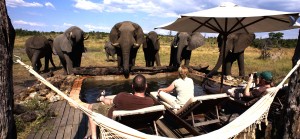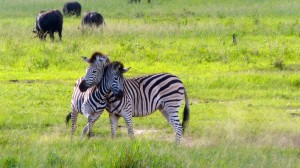Hightailing it to Hwange
“Come quietly and sit down’ our guide Nick said, moving over to the dinner table laid out by Somalisa Camp’s small pool. Kay and I negotiated the steps down to the deck carefully by the dim light of hurricane lanterns, trying not to fall on our faces or make any sudden movements. We were sitting down to dinner with an unusual guest, a big elephant bull who had come to drink out of the pool, trying his best to drain the water dry. He faced us head-on, something that would make you twitch in the bush, especially as he was only four metres away. He disregarded us, plunged his trunk into the water, slurped up the liquid and threw it down his throat. The noise was incredible. “It sounds like a really big toilet flushing” said Johnny, our host and camp manager. “They don’t drink out of the waterhole?” Kay asked. “They like the clean water,’ said Nick ‘they prefer the waterhole for mud baths.”
As we chatted over starters and broke bread, the bull moved off and another came to drink, then another. Somewhere through the main course, a breeding herd gathered around opposite us, with a very small elephant calf. We gawked at the noise of 10 toilets flushing in succession as the little calf tried to find water with its trunk. “It’s amazing how blasé you get’ said Kay ‘we’re just sitting here, having dinner and a chat.” She was right. If one of the bulls didn’t like us, it wouldn’t have taken much for him to do something about it from the other side of the pool, but they were calm and Nick was used to this behaviour. It had almost become Somalisa Camp’s guaranteed dinner-time entertainment.
Kay & I had come to Hwange during green season, a time when game viewing is far more challenging and so we were expecting game sightings to be few and far between. Luck was on side, however and on the first morning game drive into Hwange National Park we found a pack of twelve wild dogs moving along the roadside, sniffing bushes and trying to pick up the scent of something to chase for breakfast. We followed them for at least ten minutes as they scoured both sides of the road for a scent before disappearing into the thick brush. Later that day, driving with Nick from Hwange Main Camp we spotted huge amounts of plains game, zebra taking dust baths in the afternoon light, big herds of buffalo spread out across the plains and a big sable bull whose elongated horns curved all the way back to his shoulders.
As the sky started turning orange and pink just before sundowners, we found two big male lions and three lionesses stretched out over termite mounds with full, round bellies and a buffalo kill hidden in the bushes. “It’s interesting about these male lions’ Nick said ‘this one, Cecil with the big black mane is about eleven years old. One of the lion researchers around here thinks he has the biggest skull on record. He got kicked out of his territory by a younger male and was living on the periphery for ages. Then he teamed up with this other male Jericho who’s now nine and they took this area off a younger lion. It’s not often you see that. Normally once they get kicked out, they’re out. And now they have these three young girls here. They can’t be older than five. They’re all quite full with buffalo, but it looks as if one of them might be pregnant.”
The next morning the lions were still right where we left them and had begun slinking over to a nearby waterhole to drink. In the background a black-backed jackal was chewing pieces of meat off an elephant carcass as the vultures watched. We moved over to another waterhole and Nick was distracted by movement on the water. “What’s going on here?’ he said ‘I’ve never seen this before.” Sitting on the water were two Egyptian geese, determined to drown another goose by swooping on his head and forcing him underwater. The goose would then swim under water and pop up about ten metres away as his bullies scanned the water looking for him. As soon as he surfaced, the two geese would be on him again in a blaze of feathers and fury. We watched the attack, holding our breath as each attempted drowning was followed by an underwater swim and a quick breath of air before the geese were back on the trail. Suddenly it seemed a lifetime since we’d seen our half-drowned goose. We checked the surface of the water, scanning for a sign of life. Nothing. More time passed and we started to believe the goose had drowned as the other two geese started honking out cackles and flapping their wings in victory. Just as we started lamenting the goose’s demise, a little figure popped up on the side of the waterhole. He’d swam at least thirty metres underwater in a final attempt at escape. He was soggy, but undetected and alive.
We headed back to Somalisa Camp to pack our bags and move on to another part of Hwange. As we wandered around the main camp gossiping about the morning’s sightings, I was distracted by movement out the corner of my eye. Across the plain near the tree line, impala were scattering. I pointed and yelled gibberish, trying to get everyone’s attention while trying to figure out what I was seeing. “Um, lion…” I shouted on impulse, watching something straw-coloured fifty metres away chasing the antelope. “No, cheetah!” said Nick as we watched the chase becoming un-successful, the impala running faster as the cheetah slowed, panting with fatigue. Nick ran for the vehicle and brought it around as the cheetah retreated to the tree line. We were going to try and catch up with her in our last ten minutes in camp. We drove the tracks and scanned the grass. We knew the cheetah had been right where we were only moments ago. We drove forward & back, looking for leaves or grasses moving. “At this time of year, all she has to do is lie down and you’d never know she was here” said Kay. True enough, she’d disappeared for good, probably hiding no more than twenty metres from us, but in the thick shrub, we didn’t have a chance. This was why searching for game in green season held an exciting element of the unknown. You just never knew what was hiding in the long grass.
Getting to Hwange
Hwange is surprisingly close to Victoria Falls and accessible by tar all the way up to Hwange Main Camp. Road transfers from Victoria Falls town will get you to the lodges on their own private concessions bordering the park in approximately 2 ½ hrs. Flights from Victoria Falls will get you to camps within the park in 45 – 55 minutes. Due to Hwange’s close proximity to Victoria Falls, the park is a logical extension to any Botswana itinerary finishing in Victoria Falls and can be very cost-effective as compared to a delta fly-in.
Where to visit in Hwange
Like the parks in Botswana, there are no fences around Hwange National Park, meaning game can move freely between the park and the lodges on small private concessions outside the park. The terrain in the north of the park around Sinamatella features a lot of hills, granite kopjes and deep valleys, whereas Hwange Main Camp is characterised by open grassland surrounded by acacia woodland. The landscape further south towards the Linkwasha concession changes again, with more Molokwane Palm trees and open pans. The diversity of the park makes it easy to combine two separate camps in two separate areas and achieve a varied safari experience.
Lodges/Camps outside Hwange: While these properties are not technically in the park, they experience good numbers of game moving through in the dry season and some have very productive waterholes and resident populations of game that can be reliably sighted. Most of the camps offer game drives on their own private concessions with the option to game drive inside Hwange National Park as well. We recommend pre-paying park fees to provide clients with the option of both.
Camps inside Hwange: Staying inside the park provides a more intense bush experience and removes the necessity of checking in at park gates before and after game drives. The camps inside Hwange National Park have small private concessions around them, enabling more relaxed sundowners without a rush back to camp before park closing times. Some of these camps can also offer short night drives, something which is not permitted inside national parks in Botswana.
What to combine it with: Hwange is very much a dry land game viewing destination. The park roads are easy-going and very well sign-posted making it a great introduction to a safari before continuing to Botswana. Hwange National Park works very well combined with a houseboat experience or Chobe Savanna Lodge in the Caprivi (opposite Chobe National Park) for a dry land and water contrast before continuing to the dry land game viewing of the Khwai Community Area or Moremi Game Reserve.
Pre-Packaged Options: Check out our 8 Night Elephant Paths itineraries combining Hwange, Victoria Falls and Chobe or extend to a 10 Night Elephant Paths package with a fly-in to the Okavango Delta. All packages can be downloaded from our Agent’s Corner.


